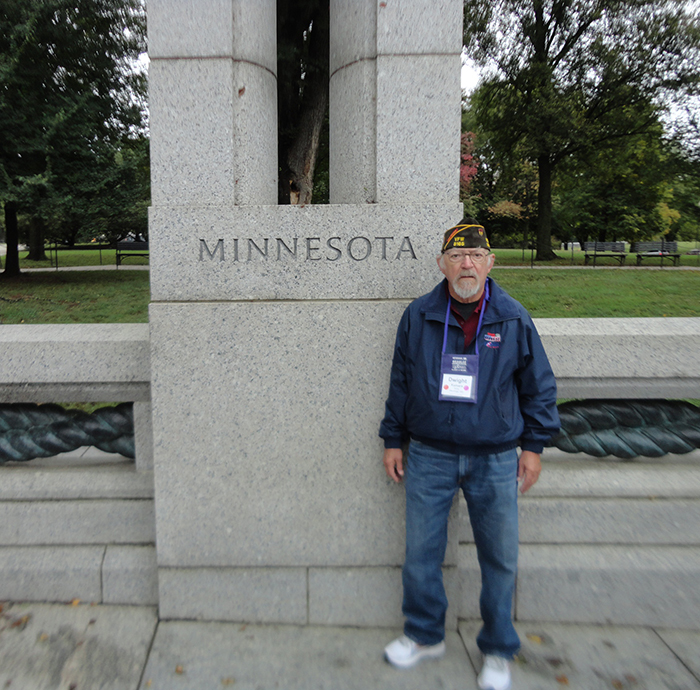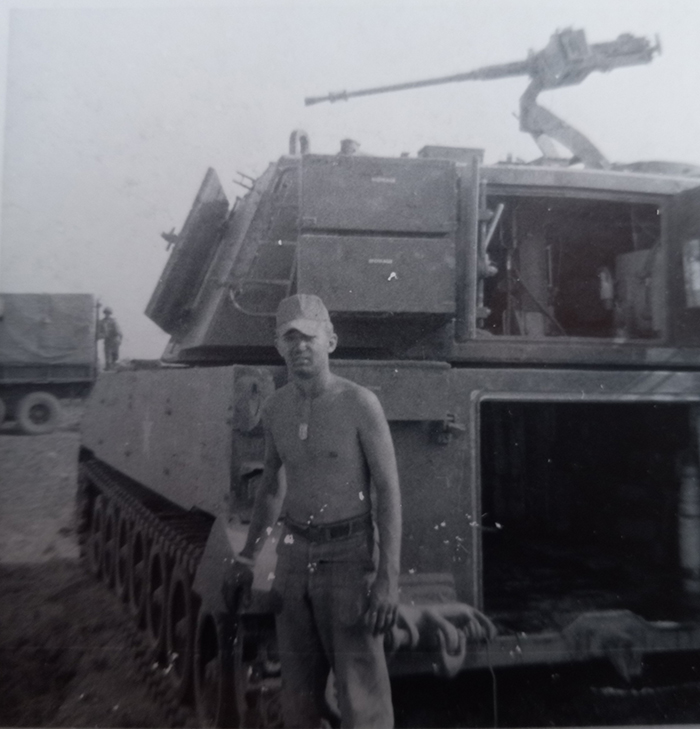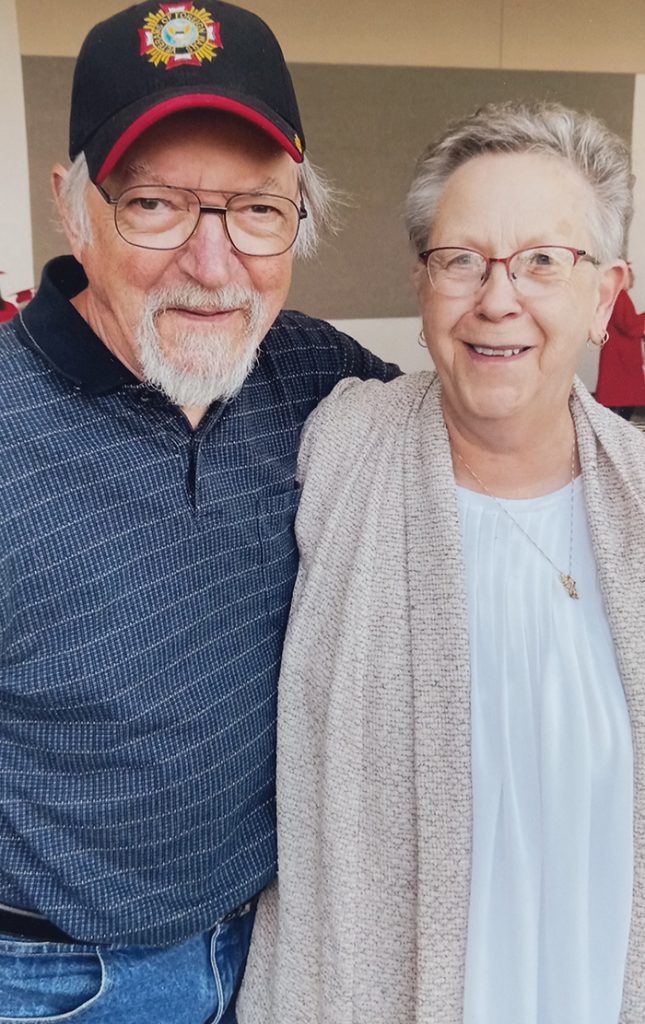Vietnam veteran shares honor flight experience
News | Published on November 3, 2022 at 11:20am EDT | Author: Chad Koenen
0
Dwight Kumara stands at the Minnesota section of the World War II Memorial in Washington, D.C.
By Vivian (Makela) Sazama
Correspondent
For Dwight Kumara of Menahga, serving in the military was something that was “just in him” and he knew he needed to go when Uncle Sam called his number in the draft. ¶ “I wouldn’t have had to go,” he said, “as I was an only child, but I knew I wanted to. Even when it meant going to Vietnam.” ¶ Dwight was born October 21, 1947, raised on a farm near Wolf Lake, and went to school in Frazee. He was just 19-years-old when he and Art Kako, also from Wolf Lake, left on August 21, 1967 for basic training (Boot Camp) at Fort Lewis, Washington for 10 weeks. Because he had been active in sports in school with cross country, track, etc. and was a “farmboy” used to hard physical labor, he said he loved Boot Camp. After basic training Dwight had a week off to return home before being sent to Fort Sill, Oklahoma, for artillery training. Upon completion there he was given a month leave and returned home to marry his high school sweetheart, Faye Markkula of Menahga.
“He was home for two weeks, then we got married and we had another two weeks before he had to leave again.”
Faye Kumara

Dwight boarded a plane to California and from there to Guam, then on to Vietnam to Tan Son Nhut Air Base in Saigon.
“The seats were all filled on the way there,” he said, “but on the way home some of those seats were empty. I served in Vietnam for one year and one day.”
Dwight was part of Company B 135th Artillery Group and was part of a six-man unit on a Howitzer with a shooting range of 20 miles.
“I was in a #155 self-propelled with a 50-caliber gun. There were other guns called an eight-inch that had a 30-mile range,” said Dwight. “We had six guys on every gun. All six of us had to know the other person’s job, so if anything happened we could step in and take over.”
The Howitzer is like a tank, but bigger, with bigger guns and slower.
“Usually we were in one position for a month or even two. We were called in to support any land forces, Army or Marines, that needed help or who were in a fire fight. We were called Fire Missions. We mainly supported Saigon, but were all over the place. The Australians were with us a lot, more or less covering them in artillery. A spotter plane above us would give us the coordinates of where to shoot. We didn’t know what we were shooting at, we only saw the devastation left behind,” said Dwight. “With all that firepower, I don’t know how anything could survive. We created devastation but didn’t see it. We were only one small piece of the puzzle. I do feel fortunate not to see a buddy blown up beside me.”
“One night we were shooting all night long. The cook was feeding us in the tank. The next morning he asked, ‘What were you shooting at?’ We answered, ‘Pa Pa Son on a bicycle.’ He asked, ‘Did you get him?’ We answered, ‘No, we missed.’”

Perhaps that was an effort to try to lighten and cope with such a very difficult and challenging situation. Dwight’s unit stayed in culverts covered in sandbags, called a “hooch”.
“One night, I was in the hooch and I asked another guy ‘What state are you from?’ said Dwight.
“He said, ‘West By God, Virginia. God only blessed that state.’ He asked where I was from. I said Minnesota. He asked me, ‘Is that in the Union?’ I told him, ‘I’ll give you some Union!’ Dwight laughed. “I served with guys from California, Texas, Florida, Georgia, Virginia and New York. There were only two of us from the Midwest in my company, myself and Stanley Docktors from North Dakota. He lives in San Diego now. We still call each other every Christmas.
“One day I was walking from one Enlisted Men’s Club to another to get out of the 100-degree temperatures and into air conditioning when I heard my last name called out. Here it was Stan Burkman from Menahga! We used to play baseball together. 6,000 miles away and here we ran into each other.”
Kumara chose Hawaii for his seven day R&R. His new bride, Faye, was able to fly there to meet him for a short honeymoon.
The troops found any way they could to keep their spirits up.
“We had a pet monkey for our mascot,” said Kumara.
Something that was hard for Kumara to see were the South Vietnamese going through the 55-gallon barrels of food garbage at the Base Camp.
“There were leftover hams and turkeys in there and other stuff,” he said. “We just don’t know what poverty is here in the U.S.”
Just before leaving his tour of duty in Vietnam Dwight picked up a blue and yellow hammock from a North Vietnamese who had died.
“They always had two things in their possession, a hammock and marijuana,” said Dwight. “I gave the hammock to an incoming soldier. While I was there heroin was leaving and opium was coming in, though I never witnessed it myself.”
Dwight still had six months left to serve after his time in Vietnam.
“I got another 30-day leave, then went back to Fort Carson for six months. When I was done with the service in December, 1969 I used the GI bill for further education. I went to the Anoka Vo-tech for welding for a year, then continued on for another six months in advanced welding.”
After Vo-tech, Dwight worked for the Barry Blower Company for a year while also working full time at Honeywell.
“I worked two 8-hour days for a year, but I was young and could handle it,” he said.
Faye also worked at Honeywell. Dwight retired in 2002 and Faye in 2003, both at age 55. They lived in Crystal, Minnesota, where they raised their two daughters, and in 2004 moved to Menahga where they built their log home.
The family farm is still near Wolf Lake.
It’s been 20 years since retirement. As Dwight looks back he remembers two local men who didn’t make it back, Vincent Shepersky and Larry Koski. He also remembers an incentive that the army gave to married men.
“If I didn’t make it back, my wife would have gotten $10,000, enough to buy a Cadillac back then!” he said.
Dwight has some opinions on the war.
“It was a blue collar war. The white collars didn’t send their sons to wars. They either went to college or to Canada. My thought is ‘If you went to Canada, stay there. Others sacrificed their lives.’”
Dwight is also firm in thinking about his time in Vietnam.
“A lot of Vietnam vets are still there in their minds. I left it behind,” he said.
However, he does support in remembering the sacrifices made there and in other wars also. His cousin, Howard Maninga has an annual Vietnam Memorial event at his home northwest of Park Rapids, which Dwight helps in by driving a golf cart to ferry people back and forth. He wants veterans to know they are not forgotten. He also went on an Honor Flight to Washington D.C. October 2, along with a Cold War veteran, Al Ohlgren of Menahga, who served in Germany. Dwight hoped to find those two vets on the Vietnam wall.
“The Veterans Administration (VA) has been good to me,” said Dwight. “They’ve supplied me with hearing aids, glasses and meds.”
Kumara has contracted diabetes, something which he said a lot of Vietnam veterans have gotten, possibly due to the Agent Orange chemicals used during the war. But overall, Kumara says he wouldn’t change anything.
“I was glad to serve the red, white and blue.”
On October 2, Kumara and Al Ohlgren of Menahga, Roger Bahls of Frazee and Lloyd Kiihn of Detroit Lakes joined 90 other veterans on an Honor Flight to Washington, D.C. They left Hector Airport in Fargo on a chartered flight along with over 100 volunteers.
Among them was Mike Morken, evening news anchor for KXJB/KVLY Fargo television. Morken took videos at most of the stops along the way. KVLY posted regular updates on their Facebook page of the trip.
“There were doctors and other medical personnel on the flight too,” said Kumara. “One of the vets ended up having a diabetic episode on the plane home and there were doctors right there to tend to him.
“We were each given a jacket, shirt and a cap,” he said. “The veterans wore lanyards with their name and their branch of military in which they served. They fed us good.”
The veterans spent two nights in Washington.
“It was raining both days we were there, remnants from Hurricane Ian,” said Kumara. “But I had always heard that it’s a trip of a lifetime, and they were right!”
The veterans visited the Vietnam Wall Memorial.
“Larry Koski from Menahga and Vincent Shepersky from Park Rapids are on that wall,” said Kumara. “We took a picture of their names.”
They also visited the Library of Congress.
“That was really interesting to me,” Kumara said. “The Declaration of Independence is there, ‘We the People.’ There are all the old murals in the rotunda but we weren’t allowed to take pictures there. All the documents were so old and under glass.”
The group also visited the various branches of the military museums.
“The Army Museum was probably the largest,” he said. “The Navy Museum only had pictures. I saw that Ernest Borgnine, who acted in the old TV show, McHale’s Navy and some other famous people were in the Navy museum.”
They went to the Arlington Cemetery and watched the Changing of the Guard at the Tomb of the Unknown Soldier.
“There are about 15 volunteers that guard it,” said Kumara. “They all have to be at least six-feet tall and weigh no more than 135 pounds. They couldn’t drink, smoke or curse. Even when they were off duty if they did any of those things they would be taken down from their post. They’re out there in every kind of weather, rain, sleet or snow. They wore sunglasses and changed their guard every hour. They were so much in step with each other. They walked out onto the end of a mat, turned and shuffled their feet. That was a salute to us veterans that were there.
“I wanted to see JFK’s eternal flame, but we couldn’t get there,” said Kumara. “There were a lot of things that impressed me, but probably the most were the volunteers. Thank God for them. They were pushing us around in wheelchairs. My volunteer’s name was Cindy, She even pushed me up a long hill. At the end I handed her a fifty dollar bill. She told me, ‘No I can’t accept that.’ I told her, ‘Yes you will. In appreciation for what you’ve done for me.’ Without her I wouldn’t have seen half of what I saw.”
The group was chauffeured around the city on four tour buses.
“Al and I were on the purple bus,” said Kumara. “Between every stop they would give us a box lunch of a chicken or roast beef sandwich, potato chips and a big cookie. They’d come up and down offering us water, juice and pop. At the end of the tour the guide thanked us all for our service. I called out ‘I have something to say’ and stood up from my seat. I said, ‘We’ve all enjoyed what we’ve seen. You’re all welcome to our town of Menahgaville, Minnesota. We’ll give you our five minute tour!’”
At the hotel where the group stayed they enjoyed a banquet both nights of their stay.
“There were two girls from the Buffalo girl band singing songs from the 60’s and 70’s,” he said. “There were supposed to be three girls, but one had a funeral to attend. They were really good. At the banquet on Monday night we were all handed an envelope. I waited until I got back to my room to open it. I couldn’t believe what was inside. My daughter Traie Docktor had gotten hold of people that were important in my life and they all sent me cards. One was from my cousin, Penny Ollila. I had sent her postcards from Vietnam when I was there. She was just a young girl then, eight-years-old. She had saved them all these years and sent them along with a card! I was in shock when I saw them. I thought they would have been thrown away years ago!”
On the trip back home the group were at the Baltimore airport when a group of young soldiers in their uniforms and duffel bags came along.
“We were arguing about lutefisk and sauerkraut,” said Kumara. “I told them Finns are known for their mojakka (vegetable beef soup), and they asked, ‘What the heck is that?!’”
As the young troops walked by, the veterans stood aside and clapped for them as they walked by. When their airplane landed back at Hector Airport in Fargo, around 200 people were waiting for them. Included were Kumara’s wife Faye and his daughter Traie.
“Mom and I got there early. We wanted to get a good spot to greet dad when he got back,” said Traie. “The plane was a little late and we stood there for 1-½ or two hours, but it was so worth it! It was so patriotic, with flags waving and a band playing patriotic songs. There was a special feel to it.”
Among the crowd were four or five WWII veterans in full dress uniform and North Dakota U.S. Senator Kevin Hoeven waiting to shake the hands of the veterans.
“There was one WWII vet on the plane,” Kumara said.
Kumara has copies of the Honor Flight application to give to any veteran who wants to go. The application can also be downloaded from the internet.
“You don’t have to be in active combat to go,” he said. “It took two years from the time of application for me to be accepted, but that was because of the virus. It was a trip of a lifetime. Every veteran should go.”

